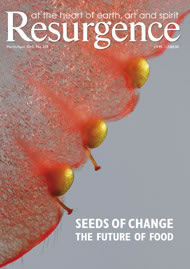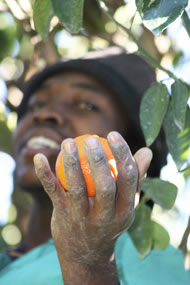Pick up a bar of Cadbury’s Dairy Milk chocolate and you’ll see the cheery blue and green FAIRTRADE Mark which is now clearly visible on the front of the pack. Walk into Starbucks and it’s hard to miss the Fairtrade branding in-store, now that, in the UK and Ireland at least, all the company’s espresso-based coffee is 100% Fairtrade – and, from next year, it will be in other European countries too. Over the last fifteen years, Fairtrade has gone from just three products mainly stocked in charity shops to more than 4,500 Fairtrade-licensed products, which last year reached an estimated retail value in excess of £700 million.
These commercial partnerships and the mainstreaming of Fairtrade are great success stories as they enable more smallholder farmers to benefit from the Fairtrade system. They also mean that Fairtrade has started to do what it first set out to achieve, which is challenge and change the problems of world free trade, by trying to create some space in the global economy where we can do trade differently.
There is no denying the fact that our food has been made cheaper and cheaper. Although partly the result of technological changes, a large part is also to do with an absolutely ruthless driving down of the prices that we pay to farmers and workers in developing countries. In Britain, the prices of our bananas have fallen by 40% in just three years. You can’t make those price cuts without passing it down to the farmers and workers in developing countries. While the free market pushes prices to farmers and workers ever further down, Fairtrade has a minimum price that covers the costs of sustainable production, with a premium for the farmers and workers to invest in tackling poverty and in promoting sustainable development.
If you look at what’s happened to commodity prices over the past four decades in real terms, you can see that from 1970 through to the beginning of this decade commodity prices for tea, coffee and chocolate, for example, have fluctuated greatly. On 22nd October 2009, cocoa prices in New York closed at a near-thirty-year high of US$3,499 a tonne, the highest since February 1980. This was due to an assortment of factors that included a weak US dollar, a global shortage of cocoa beans for the fourth consecutive year, reduced crop from Côte d’Ivoire (due to ageing trees), and an increasing demand for cocoa as reported by the European Cocoa Association which highlighted a 16.5% rise in Europe’s cocoa grind in the third quarter of 2009 alone.
When you talk to cocoa farmers about these high prices, they all say it can’t last and are worried about what will happen to them when these prices fall again in line with a free-market economy. Fairtrade seeks to challenge and to change the insecurity and threat to livelihood that the commodity market creates, by ensuring that farmers are always paid a steady minimum fair price which enables them to plan for the future, whatever the market situation.
Behind a fluctuating commodity price graph lie thousands, and in many cases millions, of shattered lives, but Fairtrade – which takes all the rules of free trade and turns them on their head, whilst still operating in the global market that dominates today – shows it doesn’t have to be like that. So while the free market drives out smallholders and unionised labour, Fairtrade works only with organised smallholders and workers who are able to organise freely. While the free market takes power and information away from citizens, Fairtrade seeks to give that information and therefore power back to farmers, workers and all of us, as citizens.
In fact, empowerment is at the heart of what’s driving Fairtrade forward because whilst the free market always puts social and environmental considerations last, Fairtrade puts them right at the heart of the system. Fairtrade says trade can only work if you put social and environmental considerations first and give farmers the resources to make things better for themselves, their own communities and their own environment.
And despite turning the rules upside down, Fairtrade seems to be working, benefiting some 7.5 million farmers, workers and their families across fifty-eight developing countries. By becoming a part of a nation’s shopping habits, Fairtrade has helped achieve significant shifts in markets and shown it can affect entire economies.
In the Caribbean island of Dominica, Fairtrade has helped to turn around the future of the entire island. Ten years ago, the number of banana farmers had dropped from a once thriving 11,000 to below 1,000 because they could not compete with the cheaper bananas being harvested from vast plantations run by multinationals in Central America. Families had broken up; people had left the island in the hope of emigrating (often illegally) and of finding work elsewhere. Gangs had sprung up, the island’s young people were carrying guns and many had turned to growing illegal drugs as a way of making money.
It was at that point that a group of banana farmers got together and formed the Windward Islands Farmers’ Association (WINFA). In the late 1990s, they became Fairtrade certified and began to sell their bananas to UK supermarkets with the FAIRTRADE Mark. Their overriding aim was to ensure that they got a fair price for their bananas, with the added bonus of a Fairtrade premium for investment in community projects, to help alleviate some of the social challenges they now faced.
Their move paid off. With the first round of Fairtrade premium money they created a football and a cricket pitch and set up several youth groups. Since then, they have used the Fairtrade funds to install street lighting to act as a deterrent to gang violence. Farmers have invested in local schools, purchased much-needed sterilising equipment for the island’s hospitals and, for the first time in a long while, felt proud to be bringing development and change to their community. And the story doesn’t end there but is ongoing now that Fairtrade bananas have become such a staple product on British supermarket shelves that one in four bananas now sold in the UK is Fairtrade.
A recent analysis of published material on the impact of Fairtrade by the Natural Resources Institute at the University of Greenwich found that there is a growing body of evidence of the positive impact of Fairtrade for producers in the developing world, from direct and indirect economic benefits through to improving community services, as well as its role in strengthening farmers’ organisations, so that they in turn can provide more services to members and help them survive in difficult times.
But I want to finish this article by not forgetting those who have been instrumental in driving this change. Fairtrade is, and continues to be, one of Britain’s most extraordinary social change success stories. Fairtrade is a people’s movement and it is ordinary people like you and me who have worked tirelessly to change consumer shopping habits. Today, in the UK alone, this strong and growing grassroots network numbers more than 450 Fairtrade Towns, 3,000 schools in the Fairtrade campaign and more than 5,000 faith groups. And that’s not even including the network of international towns that have been springing up around the world – not only a very exciting prospect but an indication of how much further Fairtrade can go.







